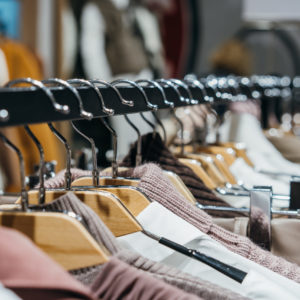Every industry has undoubtedly been impacted by the COVID-19 pandemic – but the apparel and retail industry has felt some of the biggest shockwaves. There’s no denying that this industry saw significant losses in 2020, but the opportunity for apparel and retail brands to innovate and become a consumer favorite has never been higher.
In this article, we’ll dive into the latest stats and trends around apparel and retail, how the coronavirus pandemic has impacted this industry, and tips and strategies for apparel and retail brands in 2021.
2021 Apparel Trends + Stats
The global apparel market was still worth a whopping $1.5 trillion in 2020 and is expected to grow to $2.25 trillion by 2025 and $3.3 trillion by 2030. However, the fashion category as a whole saw some steep declines in 2020, with the global fashion industry’s profit expected to have fallen 93% in 2020 after rising 4% in 2019.

Digital was crucial to apparel’s survival last year. Overall digital sales are expected to grow 20% in 2021, and online was an extremely profitable channel for apparel brands last year. US ecommerce apparel sales are expected to approach $100 billion in 2021 after hitting $91.7B in 2020. That’s almost double the growth that was seen from 2019 to 2020, with the pandemic posing a roadblock to this industry last year.
As the fashion industry begins to recover in 2021, online and omnichannel strategies will be crucial.
COVID-19’s Impact on the Apparel Industry
Casual apparel brands thrived in 2020 with consumers spending more time at home, and this trend is expected to continue into 2021 and beyond. The “athleisure” category makes up 20% of all apparel sales.
Prior to the pandemic, non-active casualwear made up over half of the overall apparel industry’s annual sales. The athleisure market is now expected to grow by as much as $81 billion from 2020 to 2024.
Activewear and casual fashion will drive apparel’s growth in 2021. Direct-to-consumer stores like Target and Walmart will also continue to drive growth in this category, especially as consumers increasingly return to in-person shopping. Amazon is also a popular choice for consumers shopping online for athleisure.
Many retailers have been forced to carefully rethink their strategy in light of COVID-19. Gap plans to double its online business by the end of 2023 and is building a $140 million warehouse to make it happen. At the same time, the retail giant is shutting roughly 30% of its North American stores.
As the leading casual apparel company worldwide (according to Statista), Gap expects that 50% of its sales will come from digital this year. Ecommerce accounted for 45% of Gap’s revenue in 2020, up from only 25% in 2019. Online sales for Gap were up 54% in 2020, while total sales declined 15.8%.
Omnichannel retailers Kohl’s and Nordstrom Inc. saw significant online growth last year, as well. Online sales for Kohl’s were up 41% in 2020, with 40% of online orders picked up in-store. Ecommerce accounted for 55% of Nordstrom Inc.’s revenue in 2020, up from 33% in 2019. 30% of online orders were picked up in-store compared to 10% in 2019.
Apparel Strategies + Tips for Brands
Most apparel brands have a secret weapon in their back pocket that many other industries don’t: consumers have traditionally been more comfortable shopping for clothes in person than online. Now that consumers are also comfortable shopping for clothes online, the omnichannel opportunity is great for apparel brands.

In fact, omnichannel customers spend 4x more than store-only shoppers and 6x more than digital-only shoppers. As the pandemic subsides and consumers feel increasingly comfortable entering stores, retailers with brick-and-mortar locations have an extra opportunity to stand out and convert customers.
The omnichannel opportunity for apparel brands also includes curbside pick-up and BOPIS. 35% of online shoppers have done curbside pickup in the past six months (as of March 2021), compared to 13% at this time last year. Shopping this way allows consumers to get their products quickly without having to spend time searching the store or waiting for shipping.
The immediacy of BOPIS and curbside pickup make these especially attractive options for consumers concerned about delayed delivery and shipment, which have been significant issues during the pandemic.
Conclusion
Apparel and retail are facing a new reality and continuing to transform as the coronavirus pandemic remains in many parts of the world. Many fashion and apparel executives felt pessimistic about the future of retail at the onset of the pandemic. Brands that have maintained a strong-willed determination to survive have thrived the most.
Are you an apparel or retail brand with big goals for 2021? Our team would love to work with you to help achieve them, whether you’re looking to increase your Amazon sales, improve your paid search presence, or optimize your website and landing pages. Reach out anytime through our consultation page to connect one-on-one with an industry expert who can help identify untapped growth potential for your business.
Sources:
- Statista. “Global Apparel Market – Statistics & Facts” https://www.statista.com/topics/5091/apparel-market-worldwide/
- McKinsey & Company. “State of Fashion 2022: An Uneven Recovery and New Frontiers” https://www.mckinsey.com/industries/retail/our-insights/state-of-fashion
- Statista. “Apparel E-Commerce Market Size in the United States from 2016 to 2021” https://www.statista.com/statistics/736612/fashion-e-commerce-market-usa/
- Technavio. “Athleisure Market Growth, Size, Trends, Analysis Report by Type, Application, Region and Segment Forecast 2021-2025” https://www.technavio.com/report/athleisure-market-industry-analysis
- CNBC. “Gap to Invest $140 Million to Build Texas Warehouse as Online Sales Swell” https://www.cnbc.com/2021/02/24/gap-to-invest-140-million-into-texas-warehouse-as-online-sales-swell.html
- Statista. “Leading Casual Apparel, Accessories and Footwear Companies Worldwide in the 12 Months Prior to June 30, 2022, by Sales” https://www.statista.com/statistics/900375/leading-casual-fashion-companies-by-sales-worldwide/
- Digital Commerce 360. “How Big Retail Chains Fared Online in 2020” https://www.digitalcommerce360.com/2021/03/09/how-big-retail-chains-fared-online-in-2020/



